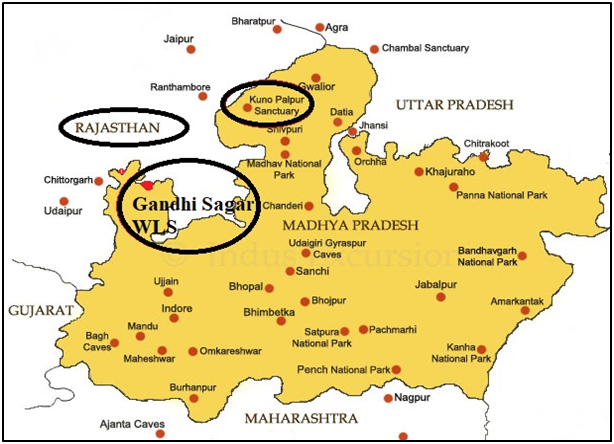Why in News?
The Madhya Pradesh government has completed its preparations for the reintroduction of the cheetahs in the Gandhi Sagar Wildlife Sanctuary, which will be the second home for cheetahs in India, after the Kuno National Park (KNP).
Under the ambitious cheetah reintroduction project, 8 Namibian cheetahs were released into enclosures at KNP in MP’s Sheopur district on September 17, 2022.Later (in February 2023), 12 more cheetahs were brought from South Africa.
What’s in Today’s Article?
- About the Gandhi Sagar Wildlife Sanctuary
- Preparations for the Introduction of Cheetahs in Gandhi Sagar
- Challenges in Making Gandhi Sagar a Viable Cheetah Habitat
About the Gandhi Sagar Wildlife Sanctuary:

- Location:
- The sanctuary (notified in 1974) is spread across (an area of 368.62 sq km) the districts of Mandsaur (187.12 sq km) and Neemuch (181.5 sq km) in western MP, right on the border with Rajasthan.
- The Chambal River cuts the sanctuary into two almost equal halves and the Gandhi Sagar dam (constructed on the river in 1960) lies within the area of the sanctuary.
- Ecosystem:
- Due to the rocky terrain and shallow topsoil, the savanna ecosystem - comprising open grasslands interspersed with dry deciduous trees and shrubs, belongs to the sanctuary.
- However, the riverine valleys of the sanctuary are evergreen.
- Why is Gandhi Sagar an ideal habitat for cheetahs? According to MP’s wildlife officials, the sanctuary makes for perfect cheetah habitat, as it looks like Maasai Mara - a national reserve in Kenya known for its savanna wilderness and wildlife.
Preparations for the Introduction of Cheetahs in Gandhi Sagar:
- Currently, an area of 64 sq km has been developed for the cheetahs, at a cost of Rs. 17.72 crores.
- A soft release enclosure (or boma, which is 1 sq km in area) has been constructed to ensure a suitable and secure habitat for the cheetahs upon their arrival.
- A hospital has also been constructed to cater to the needs of cheetahs.
- In order to gauge the existing ecological dynamics, the wildlife officials are currently in the process of conducting a comprehensive status assessment of herbivores and predators in the sanctuary.
- The Chairperson of the Cheetah Steering Committee was tasked to oversee and evaluate the overall readiness of the WLS -
- To ensure that the sanctuary is adequately equipped and prepared and
- To support the successful integration and conservation of cheetahs within its natural landscape.
Challenges in Making Gandhi Sagar a Viable Cheetah Habitat:
- Food: For cheetahs to sustainably survive in Gandhi Sagar, the first step is prey base augmentation, i.e. increasing the number of animals that the wild cats can prey upon.
- Leopard and other co-predators: Just like in Kuno, the leopard population in Gandhi Sagar will pose a threat to cheetahs, with the two feline predators possibly clashing with each other for the same prey.
- Human habitation: Unlike Kuno, highways and human habitation pass right outside the boundary of the protected area in Gandhi Sagar.
- Inter and intra state coordination: The potential of expanding the cheetah habitat in Gandhi Sagar to an area of around 2,000 sq km will depend on
- The coordination between Rajasthan’s Bhainsrodgarh sanctuary,
- As well as the territorial divisions of Mandsaur and Neemuch.
- Infection: The final call on when the cheetahs will be imported from Namibia and South Africa will be made after the monsoons, during which the cats may be vulnerable to infection.









